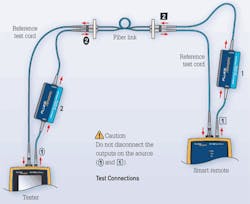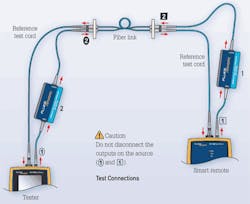Recent standards activity affects data center cabling
Two separate activities within TIA TR-42 will impact the way cabling systems are designed, installed and tested.
by Patrick McLaughlin
Two Telecommunications Industry Association (TIA; www.tiaonline.org) standards, one recently completed and one still in the works, will directly affect the way structured cabling systems are planned, designed, installed and tested within data centers.
The TIA recently published a standard for measuring installed multimode fiber-optic cabling; the standard uses the encircled flux metric for the launch condition on such tests.
TIA-526-14-B Optical Power Loss Measurements of Installed Multimode Fiber Cable Plant was "back-adopted" from part of an International Electrotechnical Commission (IEC; www.iec.ch) standard. That specification is titled IEC 61280-4-1 edition 2, Fibre-Optic Communications Subsystems Test Procedure Part 4-1: Installed Cable Plant - Multimode Attenuation Measurement. The IEC spec is where encircled flux was initially defined and referenced for multimode fiber testing.
"This is a very important document that has come out of TIA," said Bob Jensen, chair of TIA's Engineering Committee TR-42 Telecommunications Cabling Systems. "A lot of work has been done on encircled flux."
No longer in flux
The TIA's "back-adoption," as it is called, of the IEC spec means there is complete harmonization between the two. The TIA document has a foreword, which includes additional information to that in the IEC standard.
The technical detail behind the need for the encircled-flux launch condition is complex to put it mildly. But it has implications that have directly affected many fiber-optic system installers on the jobsite. Seymour Goldstein, principal engineer with Fluke Networks' (www.flukenetworks.com) media test business unit, explained it this way in an article published in 2010. "Imagine this scenario. An installation team installs a fiber plant, tests each fiber, and delivers the results to the building owner showing that all fibers have passed a certification test for fiber link loss. For a typical fiber loss, the installation technician measures 2.0 dB using a light source and power meter. The building owner then decides to spot check a few fibers using his own equipment, which includes a different light source. He gets a different result. He may measure 3.0 dB for the same link that measured 2.0 dB for the installation crew. Which light source is right? It depends on several factors."
One such factor is the light source's launch conditions. The specification of encircled flux into IEC 61280-4, and its adoption into TIA-526-14-B, are meant to eliminate the variability of light-source launch conditions.
The following three paragraphs are taken directly from the standard's scope.
"This part of IEC 61280-4 is applicable to the measurement of attenuation of installed fiberoptic cabling using multimode fiber, typically in lengths of up to 2,000 m. This cabling can include multimode fibres, connectors, adapters and splices.
"Cabling design standards such as ISO/IEC 11801, ISO/IEC 24702 and ISO/IEC 24764 contain specifications for this type of cabling. ISO/IEC 14763-3, which supports these design standards, makes reference to the test methods of this standard.
The Telecommunications Industry Association recently published TIA-526-14-B, a standard for testing installed multimode fiber-optic cabling that was back-adopted from part of an International Electrotechnical Commission standard. The standard uses the encircled flux metric for test launch conditions. Commercially available launch controllers like those from Fluke Networks shown in this illustration achieve encircled-flux compliance when coupled to a light source.
"In this standard, the fibre types that are addressed include category A1a (50/125 m) and A1b (62,5/125 m) multimode fibres, as specified in IEC 60793-2-10. The attenuation measurements of the other multimode categories can be made, using the approaches of this standard, but the source conditions for the other categories have not been defined."
942-A takes another step
During a meeting held on February 10, the TIA TR-42.1 Commercial Building Telecommunications Cabling Subcommittee took another step closer to finalizing TIA-942-A, the revision of the TIA's data center cabling standard. Jonathan Jew, who is president of J&M Consultants (www.j-and-m.com) and is taking a lead role in the TR-42.1 group that is revising the standard, offered some particulars about the standard's progress as well as how it will differ from the original TIA-942.
During the February meeting, the final committee ballot reached resolution, which means the specifications now moves on to what is known as an industry ballot. From there it goes through a default ballot before finally being published. Based on the timeframes in which balloting takes place, Jew said, "I expect we should be able to get to a default ballot within a year and publish sometime in 2012." The TIA TR-42 Committee meets three times per year, and some subcommittees also hold interim meetings to advance standards under development.
Jew authored an article that was published in the May 2010 issue of Cabling Installation & Maintenance magazine, providing an update on the progress of TIA-942-A at that time. Most of the changes he mentioned in that article have been incorporated into the standard's current draft. The following 14 major changes are in the current draft of TIA-942-A.
- TIA-942-A is harmonized with the TIA-568-C standard series including the topology, terms and environmental classifications described in 568-C.0, as well as component specifications in TIA-568-C.2 and C.3.
- The addenda, TIA-942-1 and TIA-942-2, have been incorporated into 942-A; those two addenda will be superseded by TIA-942-A.
- Grounding and bonding content from TIA-942 has been removed and incorporated into TIA-607-B.
- Administration content has been removed and incorporated into the proposed TIA-606-B.
- Most content regarding cabinets/racks and power/telecommunications separation has been removed and incorporated into the proposed TIA-569-C.
- Outside-plant pathways content has been removed and incorporated into TIA-758-B.
- The 100-meter length limitation for optical-fiber horizontal cabling has been removed. Horizontal cabling distances for optical fiber are based on individual application requirements.
- Category 3 and Category 5e are no longer recognized for horizontal cabling. The draft recognizes Category 6 and Category 6A balanced twisted-pair cable types for horizontal cabling. Both types of cabling are still permitted for backbone cabling.
- The recognized multimode optical fiber cable for horizontal and backbone cabling has been changed to OM3 and OM4 850-nm laser-optimized 50/125-micron multimode fiber cable. OM1 and OM2 are no longer recognized in TIA-942-A.
- The recognized optical-fiber connectors are LC for one or two fibers and MPO for more than two fibers.
- The intermediate distribution area (IDA) has been added to the data center topology.
- An allowance for midspan powering equipment in the zone distribution area (ZDA) has been removed.
- A section on energy efficiency has been added.
- The terms "equipment outlet" (EO) and "external network interface" (ENI) from the ISO/IEC 24764 standard have been added.
A section of the TIA's home page lists "Hot Standards." The TIA-942 and TIA-568-C standards regularly occupy the top spots in the short list of such standards. Before very much longer, TIA-942-A may be atop that list.
Patrick McLaughlin is chief editor of Cabling Installation & Maintenance.
Past CIM Issues

